While I was lounging on the poop deck of a Seastreak ferryboat (that name has always reminded me of the old Oakland Raider, Otis Sistrunk) on Saturday, September 22, 2012, getting soaked by propeller wash and fending off other photographers on an overbooked ride to visit several NYC lighthouses, a thought occurred to me. I might have discovered my ideal job. Lighthouse keeper.
For me it would be an ideal existence. Give me a couple hundred books, internet, TV, radio, a Coast Guard visit once a week to get me into town for groceries, and I’m a happy boy. I have lived by myself 30 years and have never had a sliver of desire to begin a family. Lighthouse keeping would get me even further away from the madding crowd that life in Little Neck does. However, lighthouse keeping is, even more than copy editing, an extinct job description. Most lighthouses are automated these days.
I jumped at the chance to get closer to area lighthouses. There are some land-based lighthouses but most are too far off the coast for even my 18X zoom lens to do much good. So, when the Working Harbor Committee scheduled a 3-hour tour, minus Gilligan and the Skipper, I signed up immediately. Seastreak boats, though, are far from ideal for sightseeing since they are primarily for ferry use. I persevered, but once I found a good spot on the small deck area, I stood my ground with teeth and nails. The boat traveled south from South Ferry as far as Sandy Hook Bay and then north again, past eastern Staten Island.

FORT WADSWORTH LIGHT.
First on the itinerary was the lighthouse at Fort Wadsworth, Staten Island. It entered service on 5/11/1903 atop Battery Weed, and was active until the much taller lights were placed atop the adjacent Verrazano-Narrows Bridge in 1964. The light is 75 feet above water and flashed green for aviators and white for mariners. The Wadsworth’s light is similar in its situation to the Jeffries Hook Lighthouse, or Little Red, which adjoins the immense George Washington Bridge. There has been a light tower in this location since 1828.
By 2002 the lighthouse was in decay and disarray, having been out of service almost 40 years. A lighthouse enthusiast. Joseph Esposito, organized a band of volunteers to restore it, and also obtained a $27,000 grant for the Parks Department for its restoration. The light was switched on again in September 2005, 4 months after Esposito’s death.

CONEY ISLAND LIGHT.
The Coney Island Light, located in Sea Gate at the west end of Norton’s Point on Coney Island, Brooklyn, was the last lighthouse in NY State attended by an actual keeper. Frank Schubert and his family lived in a house next to the light, and Schubert continued his watch until his death at age 88 in 2003, after 43 years as keeper and later, caretaker after the light’s automation in 1989.
One of two lighthouses in Brooklyn (the other was constructed on the Kingsborough Community College grounds in 1991) was built in 1890, flashes red and can be seen for 14 nautical miles. There are 87 steps to the top of the 61-foot tall light, which Schubert climbed daily well into his 80s. The design was copied from a now-razed lighthouse in Throgs Neck, Bronx.

WEST BANK LIGHT.
The West Bank Light, raised in 1901, is located in Lower NY Bay approximately equidistant from Staten Island and the west end of the Rockaway peninsula. It is 55 feet in height, stands on a J-shaped rock jetty, and works in tandem with the land-bound Staten Island Lighthouse near Richmondtown.
Lighthouse life is not necessarily quiet. Generators for the lights and sound equipment hum all day and night. The there are the storms…
I met a lady once who was all filled up with what she called the romance of the lighthouse. She said she often longed to be a keeper and live alone in a tower on a rock far out in the sea, and have peace and quiet. She couldn’t understand why I snorted. Peace and quiet! A lighthouse is about the noisiest place in the world. Out there on West Bank, for instance, with a gale blowing. When I was there the tower rose right out of the water, with no footing at all around it, so the waves crashed against the whole tower; shook it until sometimes the mantles over the burners in the light broke. Sometimes the waves went clear over the gallery, and the spray over the light itself. –Longtime West Bank keeper Ed Burge
West Bank Light was finally automated in the early 1980s.

ROMER SHOAL LIGHT.
Southeast of West Bank Light and north of the tip of Sandy Hook is 54-foot tall Romer Shoal Light, raised in 1898. The lighthouse, and the shoals in Lower Bay, were named for Colonel Wolfgang William Romer, a British military engineer (of German birth) who sounded the waters of New York Bay in 1700 on order of the governor of New York. There has been a day beacon, and later, a lighthouse, on this site since 1838. Along with other lighthouses of the Lower Bay, it kept close watch for enemy vessels during World Wars I and II. The aforementioned Joe Esposito helped save it when there was a possibility that it might be torn down.
The light is “in excess to the needs of the Coast Guard” and may be moved to the planned Staten Island Lighthouse Museum, which has been talked about for over a decade but is scheduled to open in 2013… we’ll see.
A shoal is a sandbar, where the sandy bottom comes close to the surface. Lighthouses warn vessels away from them.

SANDY HOOK LIGHT.
Found on the Sandy Hook peninsula, this is the oldest working lighthouse in the United States — it has been in continuous service since it was built by Isaac Conro in 1764. It’s 90 feet in height and has been using the same Fresnel lens since 1857. It was occupied by the British during both the Revolutionary War and the War of 1812, and it was turned off during WWs I and II because of its pivotal location at the entrance to New York Harbor. Though the light was automated as far back as 1964, the keeper’s house is the center for exhibits and is home base for tours.
This lighthouse was surrounded by several smaller beacons beginning in the mid-1800s. One of them was moved to Jeffries Hook in Washington Heights, Manhattan in 1917, and has been beloved to kids of many generations as the Little Red Lighthouse.
National Park Service Sandy Hook page
The [Fresnel lens] design allows the construction of lenses of large aperture and short focal length without the mass and volume of material that would be required by a lens of conventional design. A Fresnel lens can be made much thinner than a comparable conventional lens—in some cases taking the form of a flat sheet. A Fresnel lens can capture more oblique light from a light source, thus allowing the light from a lighthouse equipped with one to be visible over greater distances. wikipedia
The lens was invented by French engineer Augustin-Jean Fresnel. Before the Fresnel lens, light was emitted from lighthouses over long distances via a combination of mirrors.
NAVESINK TWINS
The brownstone twin lights of Highlands, NJ, on Route 36, were constructed in 1836 and they can be seen from as far as 70 miles in the Atlantic Ocean in some atmospheric conditions (the official number is 22 nautical miles), making them the first sign of land in many cases. The Navesink twins were the first in the country to receive Fresnel lenses, the first to use electricity, and the first wireless messages in the USA were sent between the Navesink Twins and the offshore USS Ponce. Marconi’s wireless tower was located nearby in Highlands. The Twins stand 53 feet tall and because they are situated on a cliff they are 200 feet above sea level.
Though the Coast Guard decommissioned the Twins in 1949 the north light still shines at night. The longtime keeper (1921-1952) was named Murphy Rockette.

GREAT BEDS LIGHTHOUSE.
Located in Raritan Bay off the coast of Wards Point, Staten Island, Great Beds Lighthouse was constructed to guide bay traffic around the treacherous Great Beds Shoal in 1880. Its conical shape makes it unique among the lighthouses of southern NY Harbor. It’s one of the tallest in the group as well, standing 60 feet tall. It can be sighted (best with a binoculars) from the new pedestrian paths in Staten Island’s Conference House Park. It is technically in New Jersey, and its construction was delayed for 2 years while it was decided what state would claim it.
In the 1880s, two consecutive keepers, George Brennan and John Johnson, died and disappeared, respectively, under mysterious circumstances.
The “Beds” in the name refers to oyster beds, which were plentiful in the waters surrounding the NYC area.

PRINCE’S BAY LIGHT.
Located in Prince’s Bay, an inlet of Raritan Bay near Sharrotts Avenue and Hylan Boulevard. The bay, and the surrounding neighborhood, were named for William, Prince of Orange, who became King of England in 1689. He was the William of William and Mary and the King Billy of the Irish nursery rhyme:
Up the long ladder and down the short rope
The hell with King Billy and God bless the Pope.
The current lighthouse was constructed in 1864 for the sum of $30,000 which was approved by Congress. The attached lightkeepers cottage was completed in 1868. Previous lights had shone from Prince’s Bay since 1837.
The Princes Bay Lighthouse was deactivated in August 1922, after the installation of acetyline lights in Raritan Bay made the former lighthouse obsolete. The Mission of the Immaculate Virgin at Mt. Loretto, a Catholic orphanage founded by Father John Christopher Drumgoole purchased the lighthouse, cottage and an additional outbuilding in 1926. wikipedia
The rear range light on the beach at the water’s edge was erected in 1953.

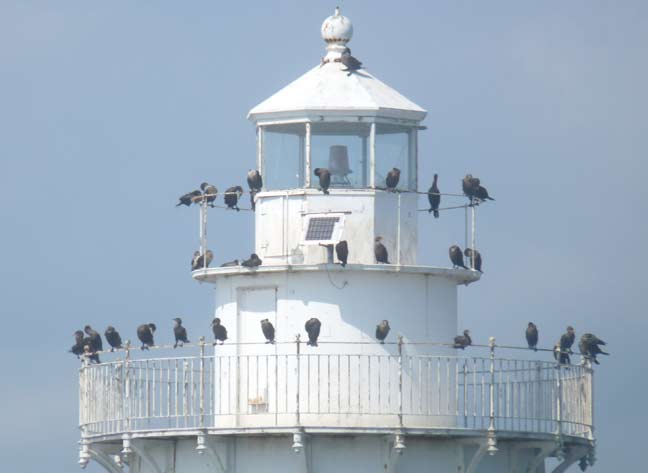
OLD ORCHARD (SHOAL) LIGHT.
A favorite with the cormorants in Raritan Bay, the Old Orchard Light can be seen (again, best with binoculars) from the Crooke’s Point area in Great Kills State Park. It is 35 feet tall and was automated in 1955. Frank Schubert, the longtime Coney Island Lighthouse keeper, served at Old Orchard for three years. It is far out in Raritan Bay, about 3 miles from the Staten Island shore, and was placed in service in 1893.
This lighthouse was destroyed by Hurricane Sandy a few weeks after I obtained these photos.
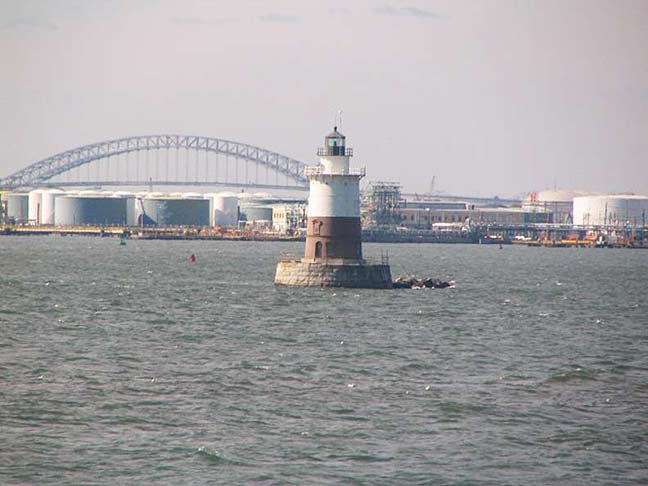

ROBBIN’S REEF LIGHT.
I’ve discussed Robbins Reef Lighthouse and its colorful history in a 2011 ForgottenSlice. It’s located in Upper New York Bay east of Bayonne and north of St. George, Staten Island and can be seen by daily ferry commuters as well as the many tourists that ride the ferry.
The present light was built in 1883 and was kept for many years by Kate Walker after her husband, John, passed away in 1886. She and her two children lived at the light and she would row the kids to a school in Staten Island. During her time at the lighthouse she was credited with 50 rescues.
There has to be a movie in Kate Walker’s story, eventually.
Since our boat passed under the Verrazano-Narrows Bridge twice, I took advantage and got a few pictures. It’s a lighthouse in its own right, with red lights atop its two towers. I watched the bridge get built from my home in Bay Ridge from 1959-1964.
9/23/12
SOURCES:
Lighthouses of New York, Jim Crowley, Hope Farm Press 2000


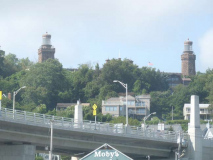
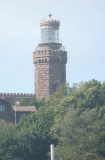
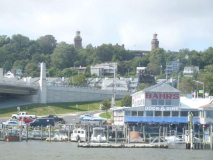
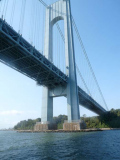
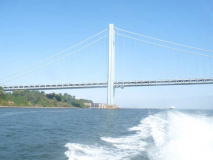
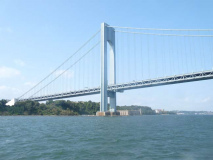
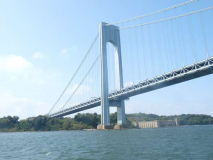
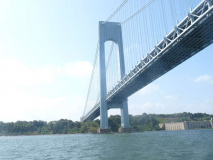
25 comments
I’ve always wondered why Breezy Point never had a lighthouse.
“Seastreak” reminds me of the “Sky Streak” elevators at the New York State Pavillion, World’s Fair.
Maybe you could take up lighthouse keeping with this gal…
http://www.youtube.com/watch?v=wNTf8iublLc&feature=related
Great post.
Very illuminating.
The very tip of Breezy Point does have a small light tower at the very tip of it’s rock jetty. It also has a building that looks like a lighthouse along Jamaica Bay that looks like a lighthouse but was in fact part of the battery system that protected NY Harbor. It still stand and was repainted. Due to drgeing iut’s no longer in the water. It’s also no longer open. As a teen we would go in there but it was gorss; years of caked seagull guano.
http://deepcreekyachtclub.com/WebPage/BPTower.html
Kevin, you have done this old sailor proud. Nice work. Verrazano looks good. Been under it a few times myself. It doesn’t seem to get the respect that some of the other bridges do. Maybe it needs its own McCullough.
a very interesting and informative post!
What about Ambrose Light House?
http://njscuba.net/gear/misc_uscg3.html
The Orient Point Lighthouse is for sale! http://realestatesales.gov
Robbin’s Reef is now being restored by the John Noble Maritime Museum, which BTW is a great place to visit at Snug Harbor:
http://noblemaritime.startlogic.com/robbins_reef.html
I noticed in some of your photos that there appears to be solar panels attached to some of the lighthouses, either at the base or up top. Am I correct? If so, I’m guessing this is part of the automation process….
For years I’ve scrutinized two of these lighthouses via binoculars from Coney Island. Nice to see them up close, with history.
I’m a huge fan of lighthouses, and if anyone else is interested in their preservation, I recommend becoming a member of the American Lighthouse Foundation. I was recently in Maine and visited the lighthouse at Pemaquid, which had been closed due to deteriorating conditions when I first saw it in 2000. Now it’s beautifully restored and open to the public.
Wonderful, informative post – thank you Kevin.
On your sail down to Sandy Hook did you happen to come across two islands in the Lower Bay? Hoffman and Swinburne if I recall. My father used to talk about them from his sailing experience. I don’t know if they’re still used, but I believe one might have had a crematory.
My grandfather was the lighthouse keeper at Throgs Neck., Bronx. I believe that is the “now razed
lighthouse” that the Coney Island Light was copied after. There are many stories that are part of my family’s history connected with the light that once stood at Fort Schuyler.
Unfortunately, the Old Orchard Shoal Lighthouse did not survive Hurricane Sandy. It was completely destroyed. See the photos and story:
It’s so sad that the Old Orchard was a landmark victim to Hurricane Sandy. I hope that its salvage and restoration plan becomes a reality
I was one of the last Coast Guard lightkeeper at Romer Shoal Light ’64-’66. It was automated soon after I left. A three-man crew with two men there at a time. Great view of the Coney Island fireworks. Watched the Verrazano Bridge being erected. I loved the isolation. Was there for the Great East Coast Blackout. Sorry lady lighthouse buffs, no girls were allowed.
Please stop sending images to my facebook page. This is the only contact form I have found on your site. Please, Please stop. My name is Virginia Willits, my email address is ginnyw@aol.com
Thank you.
I’m not sending any images to your facebook page.
I do not believe that the British occupied the Sandy Hook Light at any time during the War of 1812.
Did you forget the Statue of Liberty?
I would love to work at a lighthouse. I live in New York City though.
Can someone refer me to someone that hires lighthouse keepers? 😉
When I visited the Lighthouse Museum in Saint George, I was told Kate Walker’ didn’t row the kids every day. During the school year they stayed on Staten Island